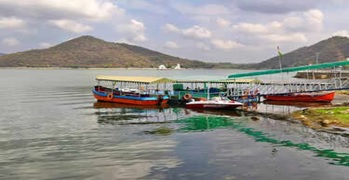28 September, 2025
Gokul Reservoir and Udaipur Lake Declared as Wetlands of International Importance (Ramsar Sites)
Tue 30 Sep, 2025
Reference:
- Gokul Reservoir in Buxar district and Udaipur Lake in West Champaran district, Bihar, have been designated as wetlands of international importance (Ramsar Sites).
Key Points:
- With this recognition, the total number of Ramsar sites in Bihar has increased to 5, and in India to 93.
- In terms of the total number of Ramsar sites, India ranks 1st in Asia and 3rd globally (after the UK with 176 and Mexico with 144).
- Both are man-made reservoirs, important for irrigation and biodiversity conservation.
- They were recommended for inclusion in the Ramsar list in 2023 by the Bihar State Wetland Authority (BSWA).
Gokul Reservoir, Buxar District :
| Feature | Details |
| Location | Buxar District, Bihar (near River Ganga) |
| Area | 448 hectares |
| Year of Construction | 1980 (for irrigation purposes) |
| Type | Man-made Reservoir |
| Primary Purpose | Irrigation, flood control, biodiversity conservation |
| Biodiversity | 100+ migratory bird species (e.g., storks, kingfishers, waterfowl); aquatic plants |
| Environmental Significance | Flood control (20–30% intensity reduction), groundwater recharge, carbon sink |
| Economic Significance | Irrigation of 10,000 hectares farmland, fisheries, tourism potential |
| Social Impact | Supports livelihoods of local communities (farmers, fishers) |
Additional Information:
- Geographical Importance: Located in the Ganga Basin, crucial for water management in flood-prone areas. Helps mitigate climate change effects (e.g., irregular monsoon).
- Tourism Potential: Ramsar tag will enhance birdwatching and eco-tourism opportunities.
- Challenges: Urbanization, agricultural chemical pollution, and illegal hunting.
Udaipur Lake, West Champaran District :
| Feature | Details |
| Location | West Champaran District, Bihar (Terai region, Gandak River Basin) |
| Area | 319 hectares |
| Origin/Construction | 1990s (human-made structure for irrigation and water storage) |
| Type | Semi-natural (natural-human hybrid) lake |
| Primary Purpose | Irrigation, fisheries, flood control, biodiversity conservation |
| Biodiversity | Migratory birds (e.g., waterfowl, kingfishers), fish species (carp, catfish), aquatic plants (lotus, reeds) |
| Environmental Significance | Groundwater recharge, flood control, carbon sink, pollution filtration |
| Economic Significance | Fisheries provide income to 5,000+ families (~₹50 lakh annually), tourism potential |
| Social Impact | Supports livelihoods of local and tribal communities (e.g., Tharu tribe) |
Additional Information:
- Geographical Importance: Located in the Terai region, assists in Gandak River water management. Important for flood control and groundwater conservation, especially during monsoons.
- Tourism Potential: Ramsar tag expected to boost birdwatching and eco-tourism, benefiting local economy.
- Challenges: Pollution from agricultural chemicals, illegal fishing, drainage problems. Local conservation and monitoring required.
- Social Contribution: Fisheries and water storage provide livelihood for tribal communities like the Tharu.
- Biodiversity Count: Over 280 plant species and 35 migratory bird species present.
Wetlands (General Information)
| Feature | Details |
| Definition | Areas between land and water where soil is water-saturated or surface water is present |
| Types | Natural (e.g., swamps, floodplains, lakes) and man-made (reservoirs, ponds) |
| Primary Purpose | Biodiversity conservation, flood control, groundwater recharge, pollution filtration, livelihood support |
| Biodiversity | Birds (e.g., migratory waterfowl), fish, amphibians, reptiles, aquatic plants (lotus, reeds) |
| Environmental Significance | Carbon sink, climate regulation, soil erosion prevention, water purification |
| Economic Significance | Fisheries, irrigation, tourism (birdwatching), local employment |
| Global Context | Protected under Ramsar Convention (1971); India has 93 Ramsar sites (as of Sept 2025) |
| Status in India | 1.36 million hectares; Bihar 0.37 million hectares (~4% of land) |
Additional Information:
- Ramsar Convention: Established 1971 in Ramsar, Iran. Promotes conservation and wise use of wetlands. India has been a member since 1982, holding the most Ramsar sites in Asia (93).
- Bihar Wetlands: Kabartal, Nagi-Nakti, Gokul Reservoir, Udaipur Lake, and Kanwar Lake. Part of the Ganga-Brahmaputra basin.
Significance:
- Environmental: Flood control (20–30% reduction in flood intensity), groundwater recharge, biodiversity protection (100+ bird species, fish, Ganga dolphin).
- Economic: Fisheries provide income to thousands of families; tourism generates employment.
- Social: Supports livelihoods of local and tribal communities (e.g., Tharu).
- Challenges: Urbanization, pollution (agricultural chemicals), illegal hunting, drainage issues. Bihar lost ~30% of wetlands in the past decade.
- Conservation Efforts: India’s Mission Amrit Sarovar and National Wetland Conservation Programme support wetland restoration and protection.
Ramsar Convention
- International treaty promoting conservation and sustainable use of wetlands.
- Also known as “Convention on Wetlands.”
| Feature | Details |
| Established | February 2, 1971, Ramsar, Iran |
| Objective | Wetland conservation, wise use, biodiversity protection |
| Signatories | 172 countries (as of Sept 2025); India since 1982 |
| Focus | Wetland ecology, water management, community livelihood |
| Ramsar Sites | Wetlands of international importance |
| Global Status | 2,500+ sites, 250 million hectares (2025) |
| India Status | 93 sites, 1.36 million hectares; 1st in Asia, 3rd globally |
| Bihar Ramsar Sites | Kabartal, Nagi-Nakti, Kanwar Lake, Gokul Reservoir, Udaipur Lake |
Montreux Record :
- A register under the Ramsar List for wetlands where ecological character has changed, is changing, or is likely to change due to human intervention, pollution, or development.
Purpose:
- Monitor threats to critical wetlands.
- Provide guidance for conservation and restoration.
Indian Wetlands in Montreux Record:
1. Keoladeo National Park, Rajasthan
- Added: 1990
- Location: Bharatpur, Rajasthan
- Features: Bird sanctuary, UNESCO World Heritage Site
2. Loktak Lake, Manipur
- Added: 1993
- Features: Largest freshwater lake in Northeast India, famous for “Phumdis” (floating vegetation)


















